Abstract
1. The effects of galvanic stimulation of the vestibular apparatus (with electrodes on the mastoid processes) have been studied in standing human subjects. With the head turned to one side, subjects swayed towards the anode. 2. Forwards sway was preceded by electromyographic (EMG) activity in quadriceps and tibialis anterior muscles. Backwards sway was preceded by EMG activity in soleus and hamstring muscles. 3. Using the method of H reflex conditioning, forward sway was found to be preceded by inhibition of soleus motoneurones. 4. Interaction between the vestibular-evoked inhibition of soleus motoneurones preceding forwards sway and peripheral reflex inhibition was examined by a spatial facilitation method. 5. Interaction was found between vestibular-evoked inhibition and Ia reciprocal, group I non-reciprocal and group Ia-Ia presynaptic inhibitory pathways. It is concluded that vestibular signals converge on spinal interneurones subserving these inhibitory actions. 6. A 'decoupling' of soleus motoneurons and soleus-coupled Renshaw cells was found in the period of soleus activation preceding backwards sway.
Full text
PDF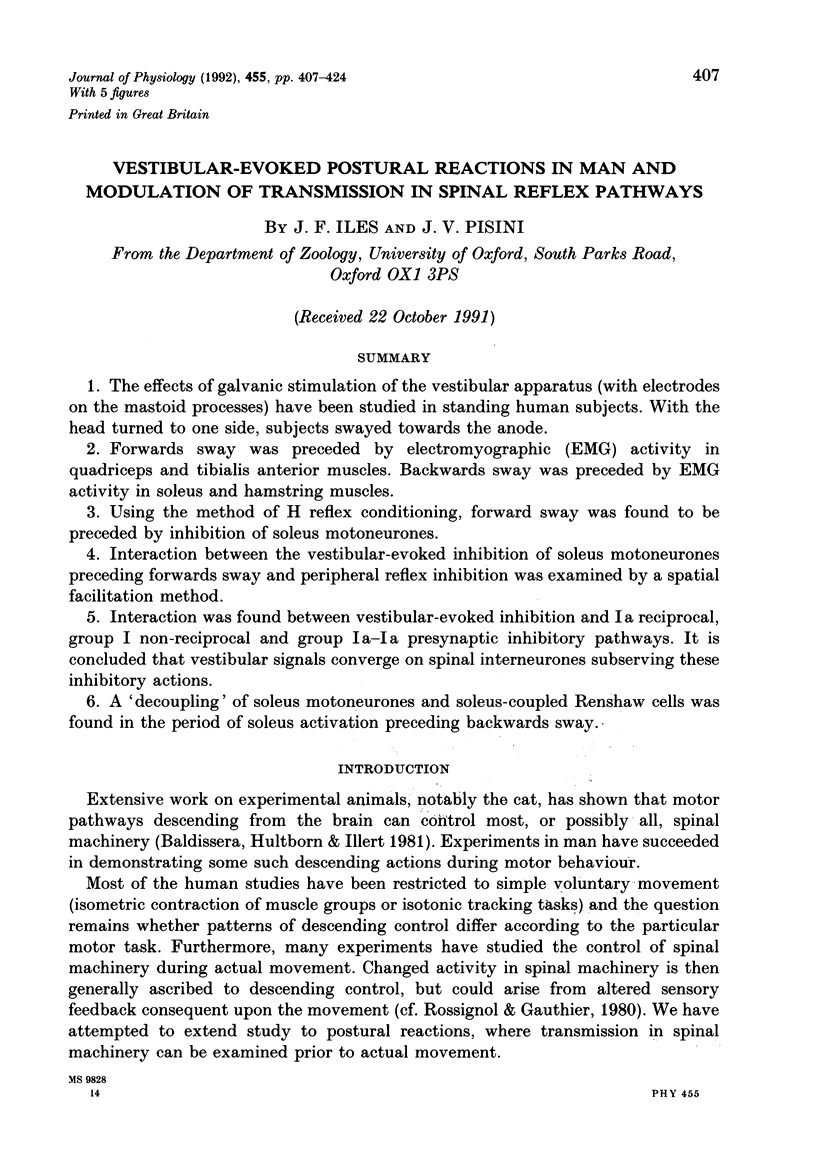
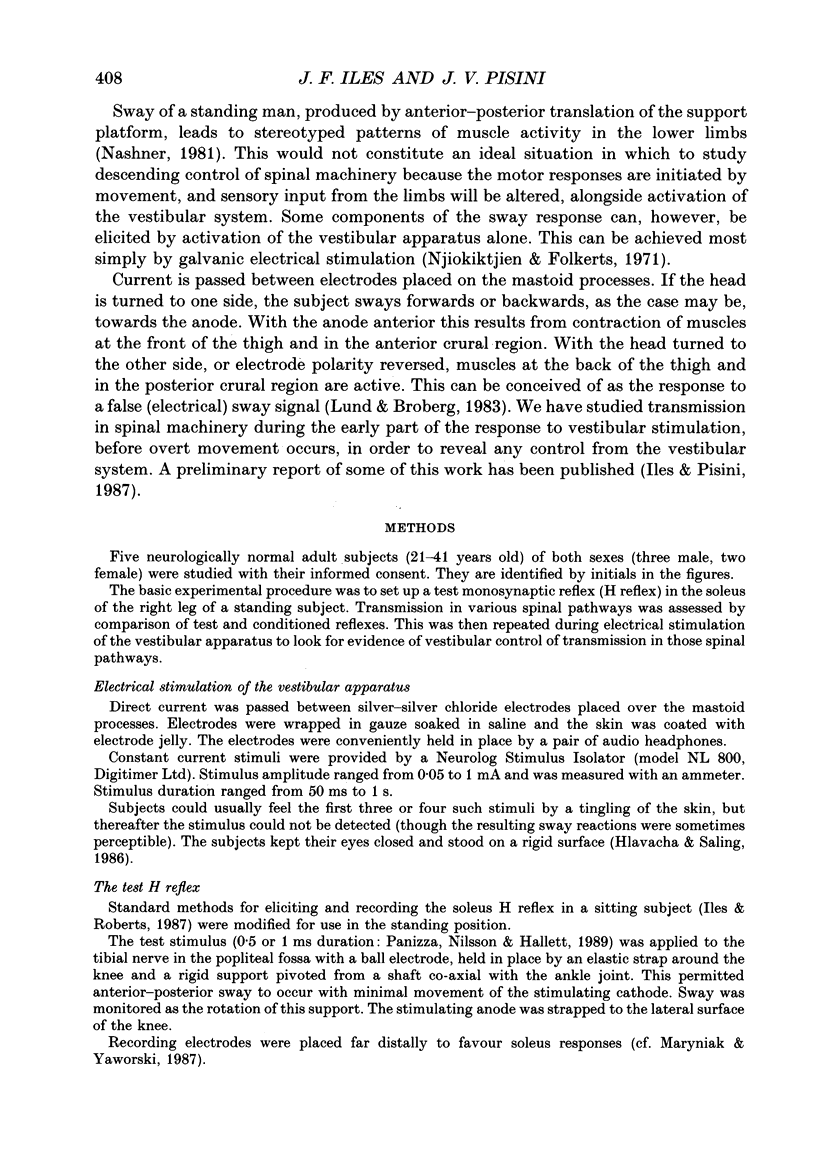
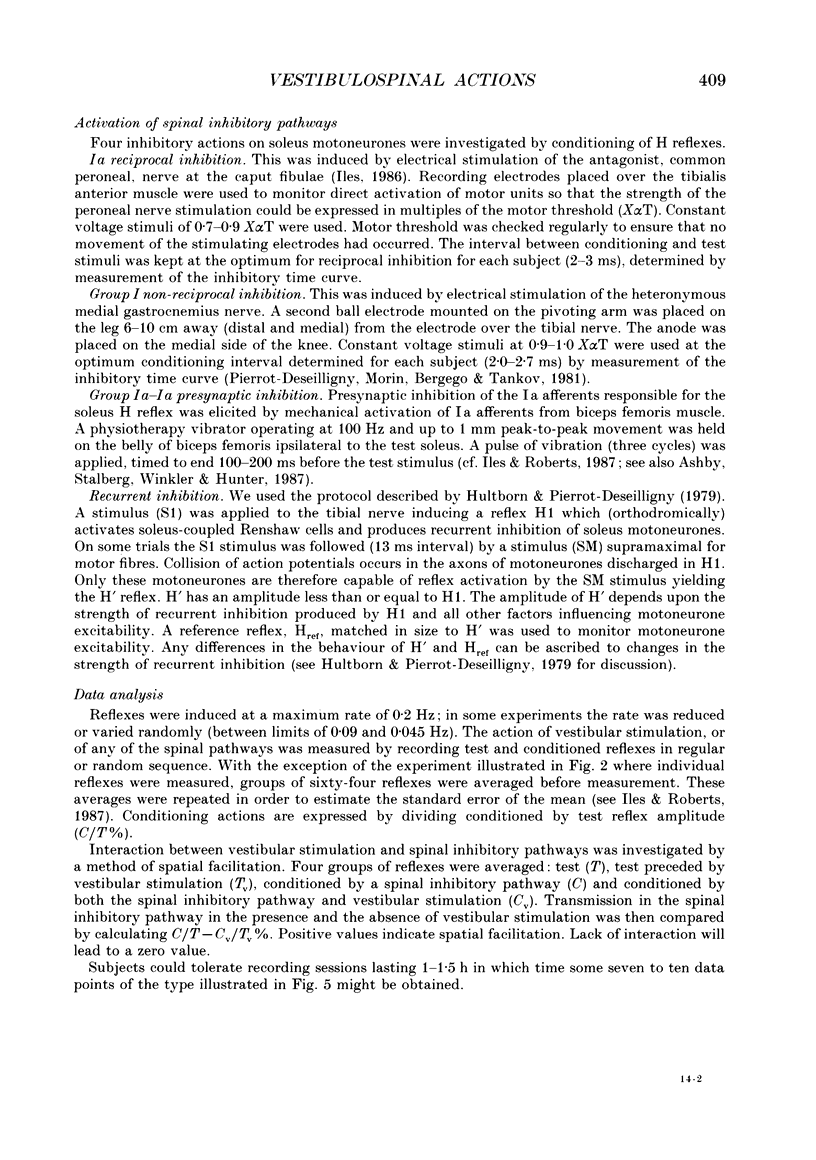
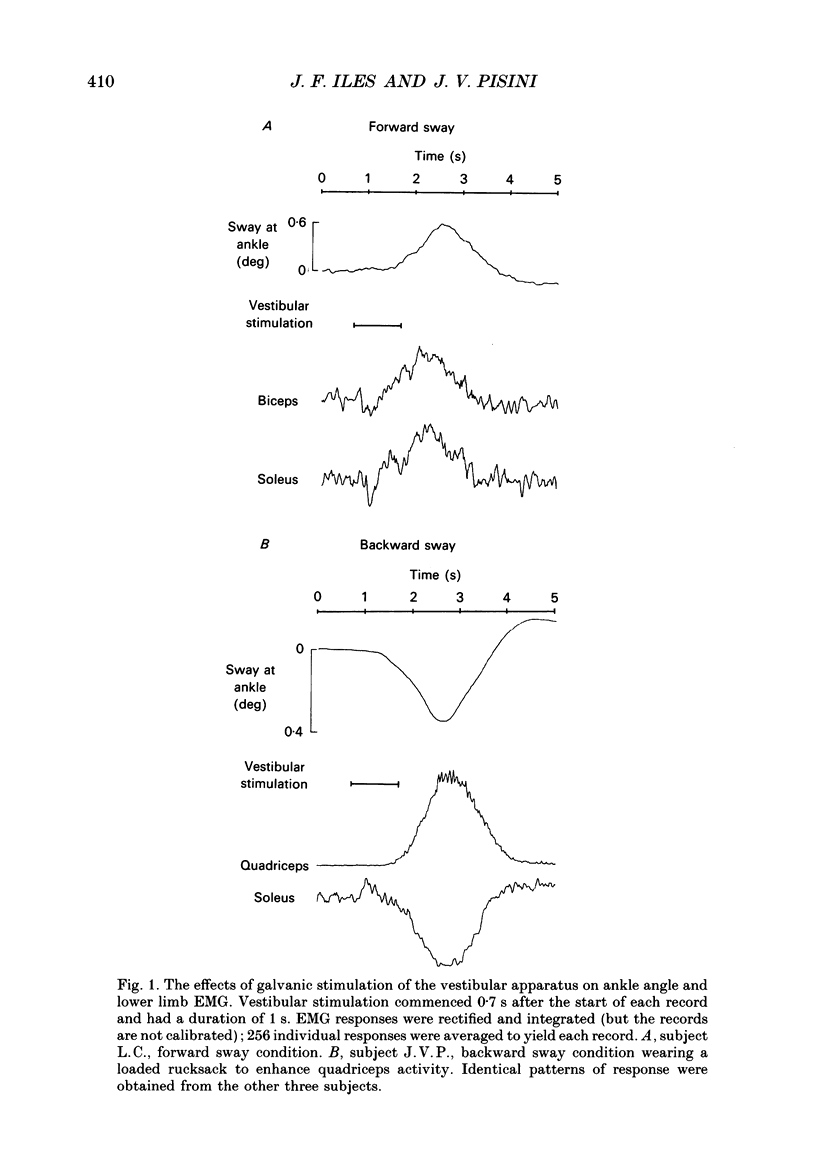
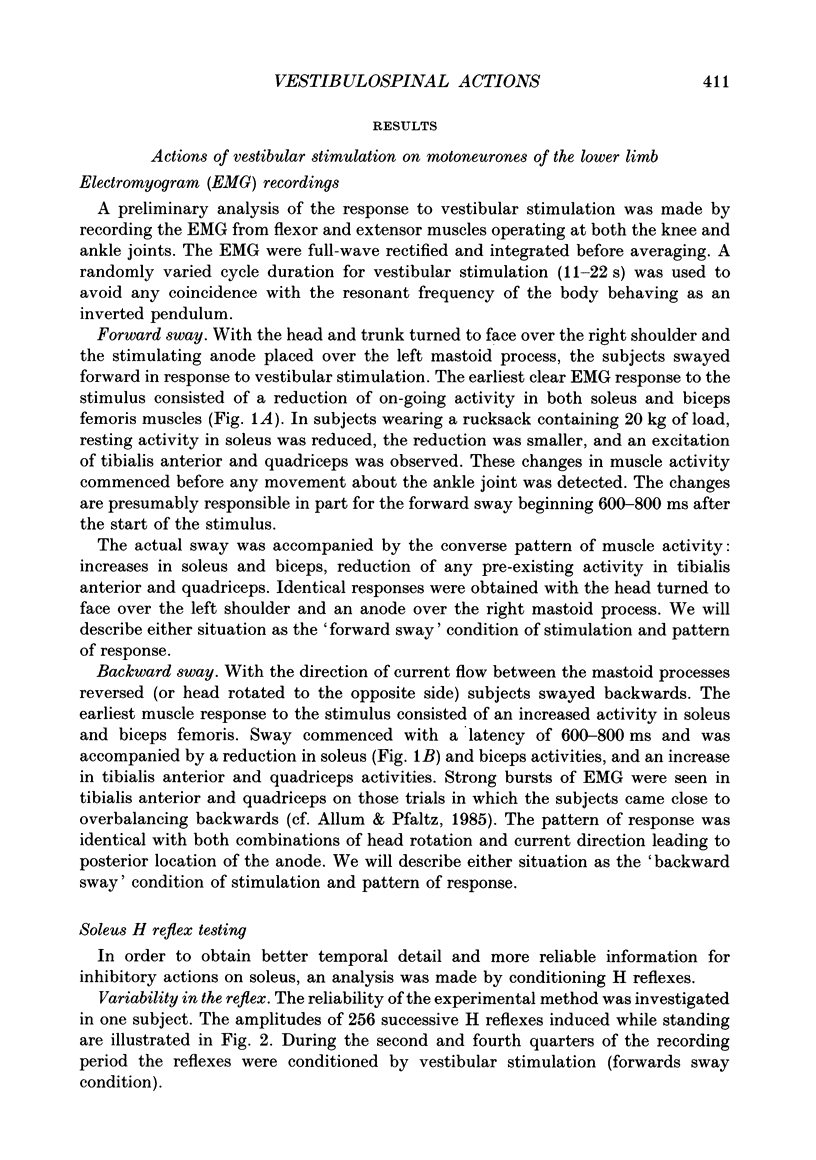
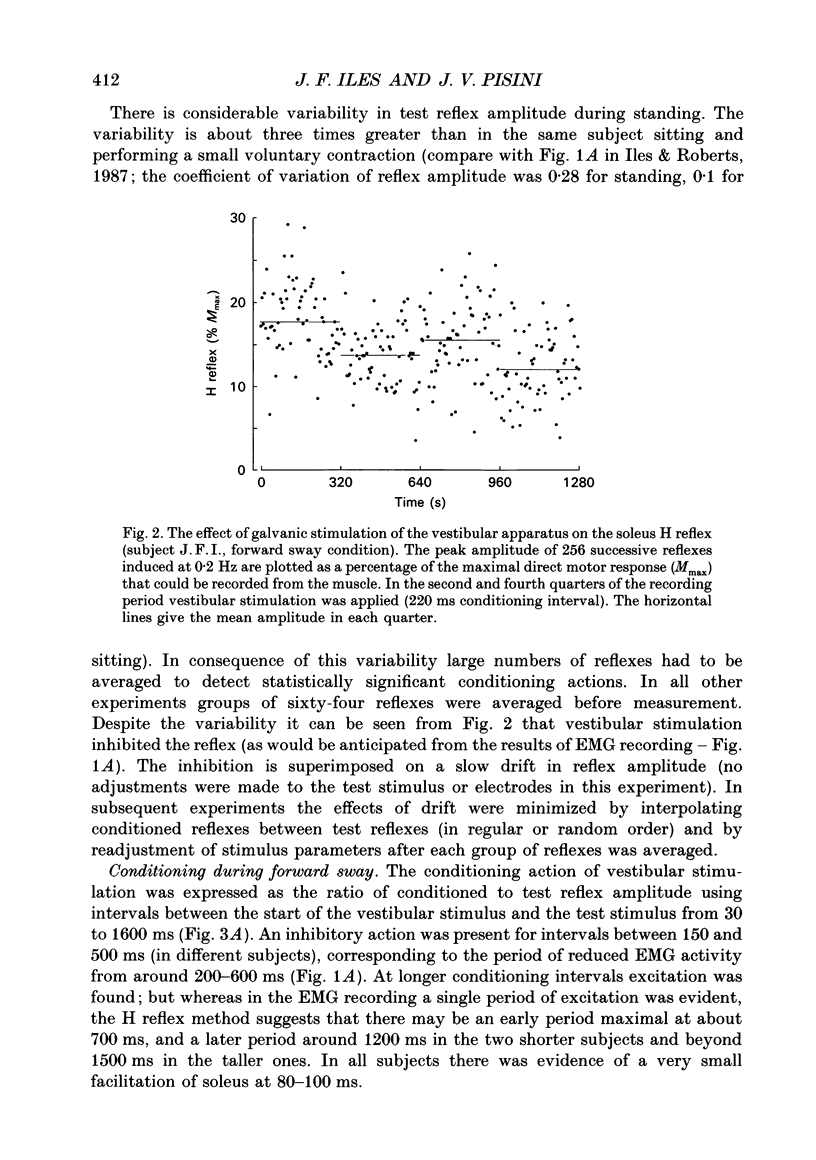
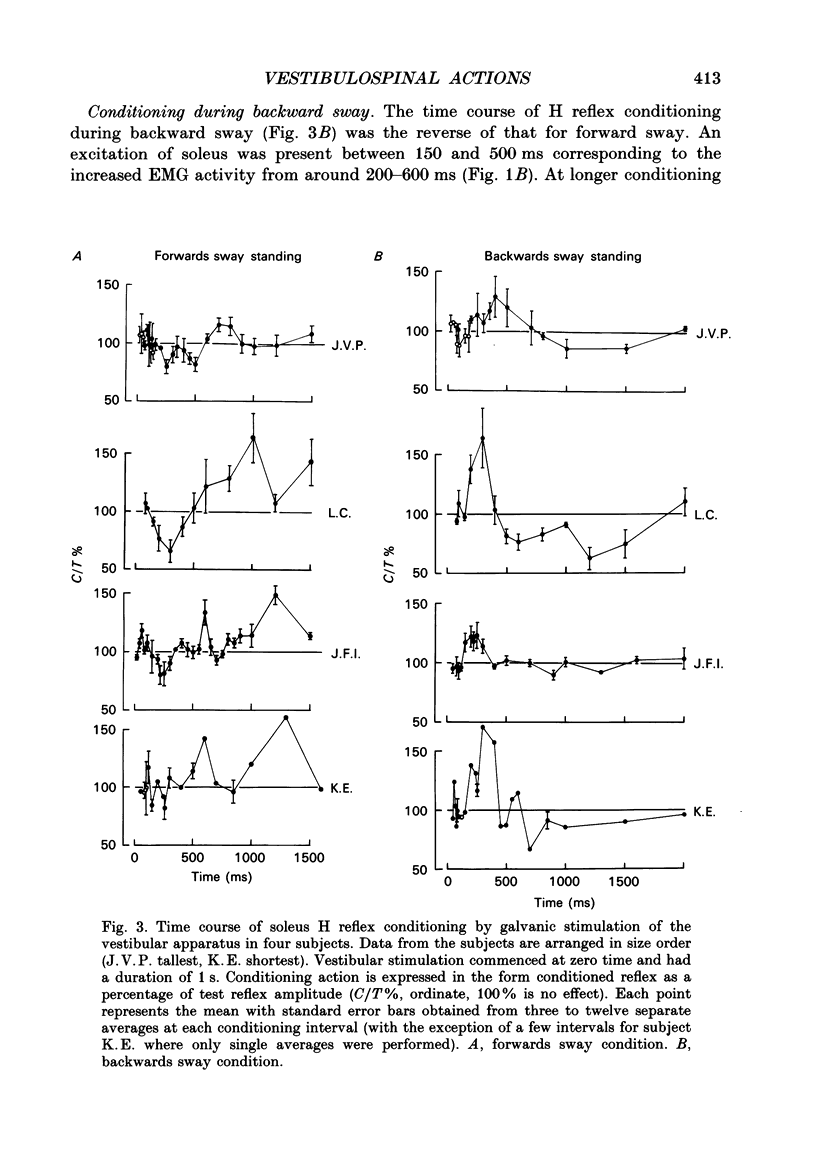
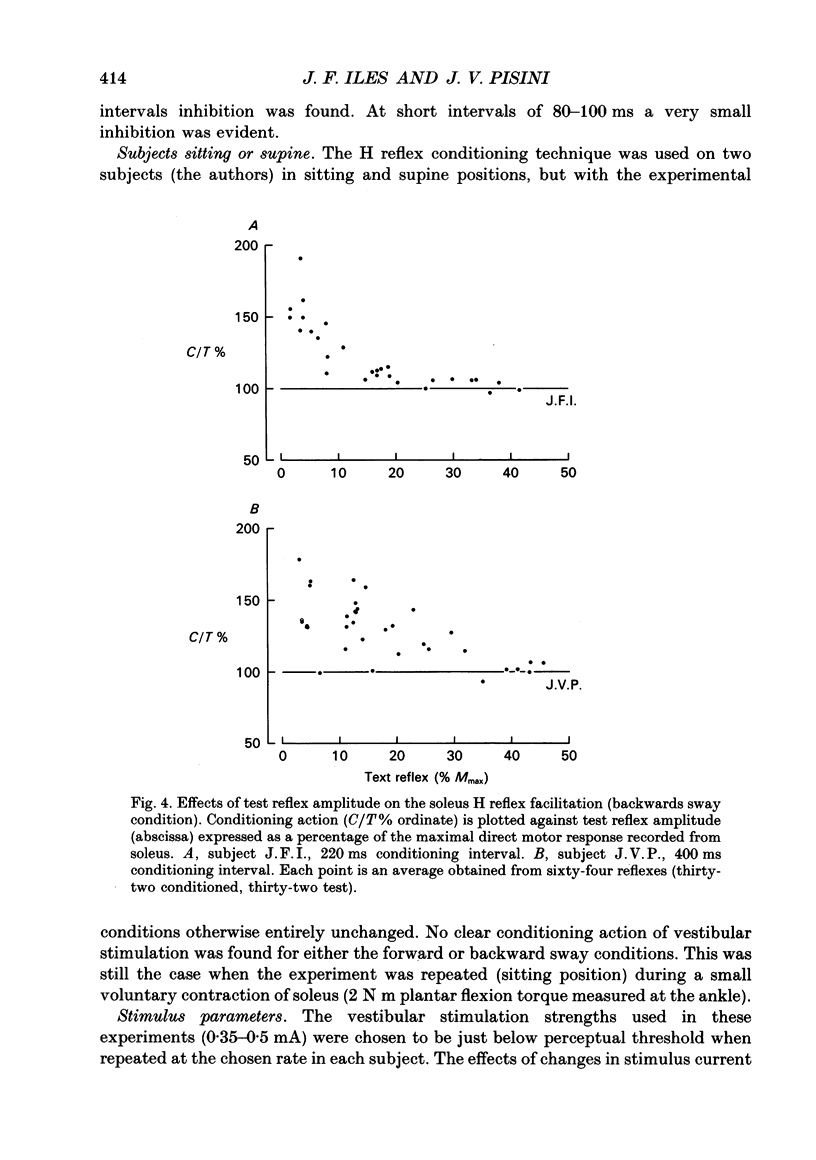
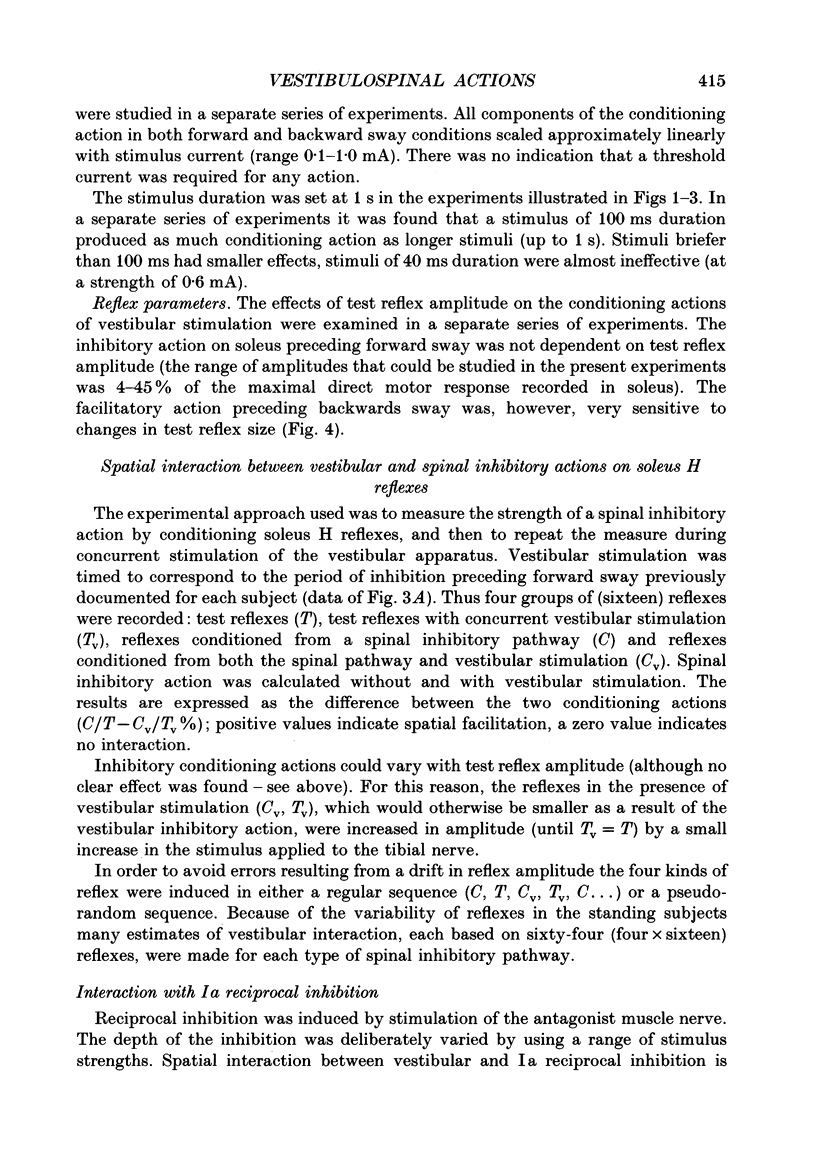
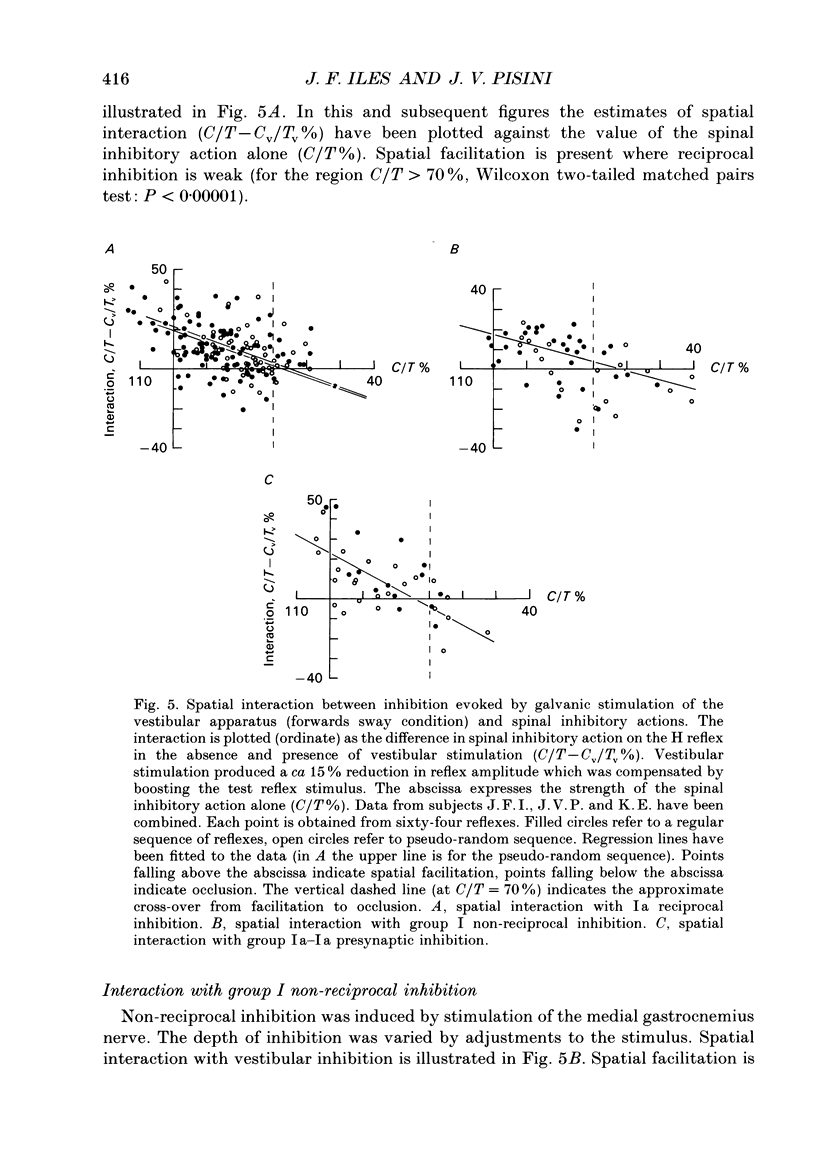
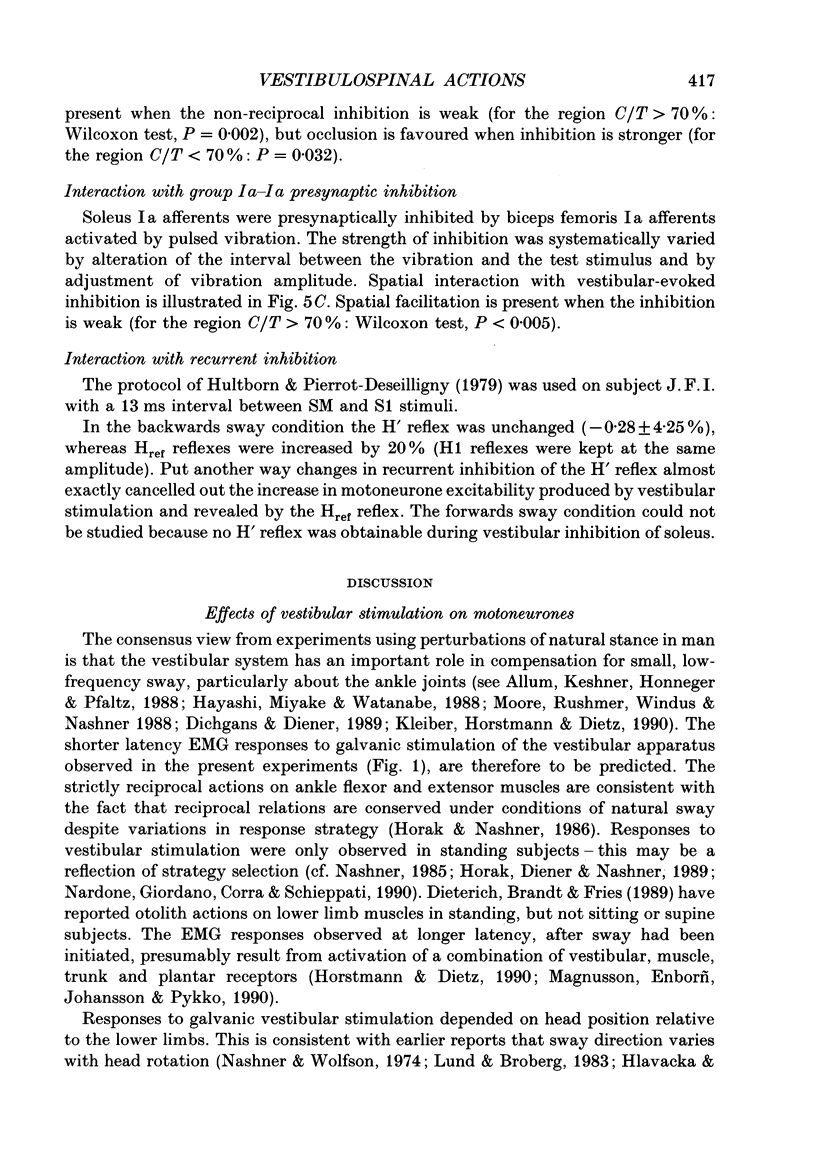
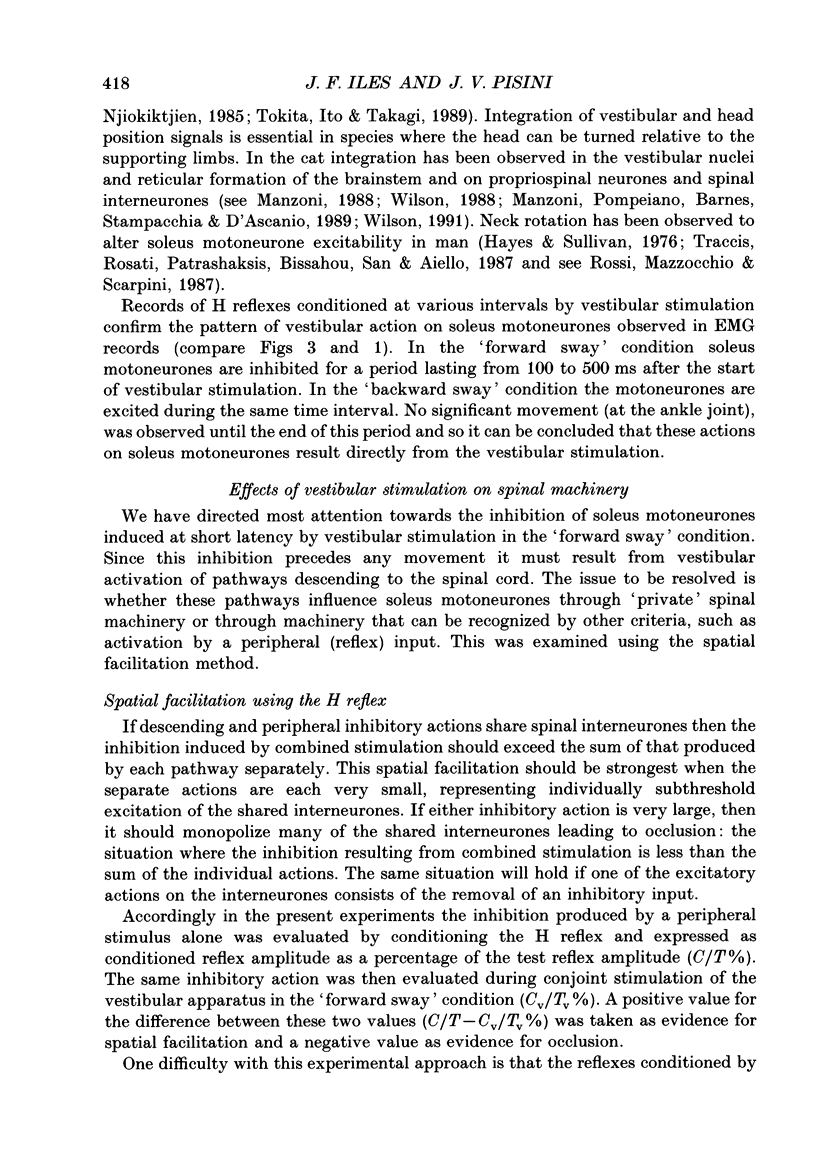
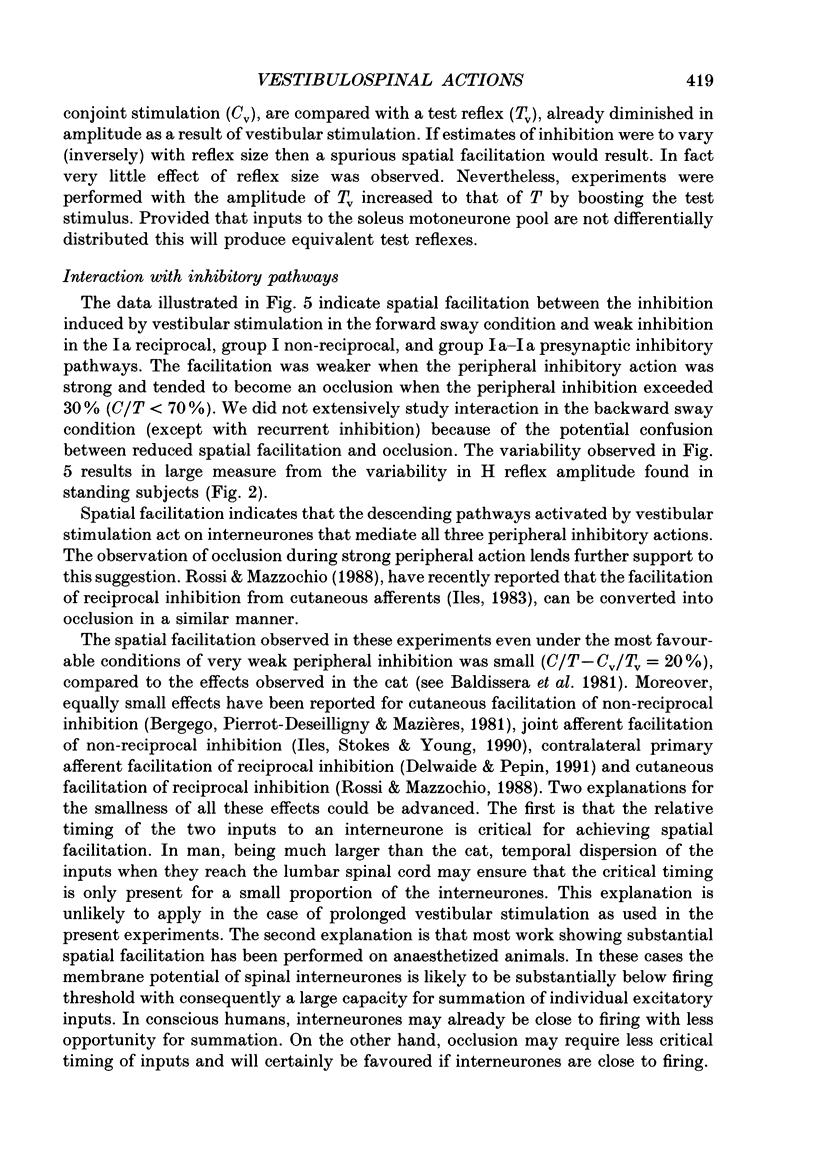
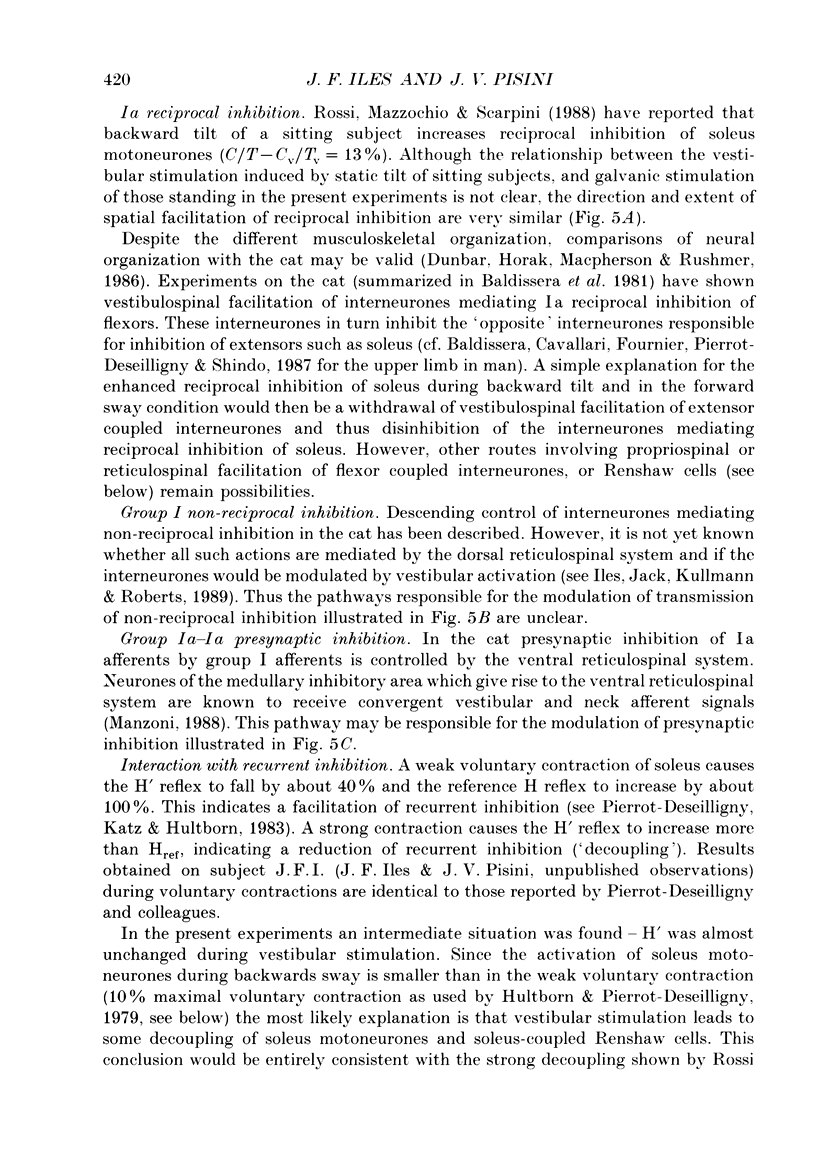
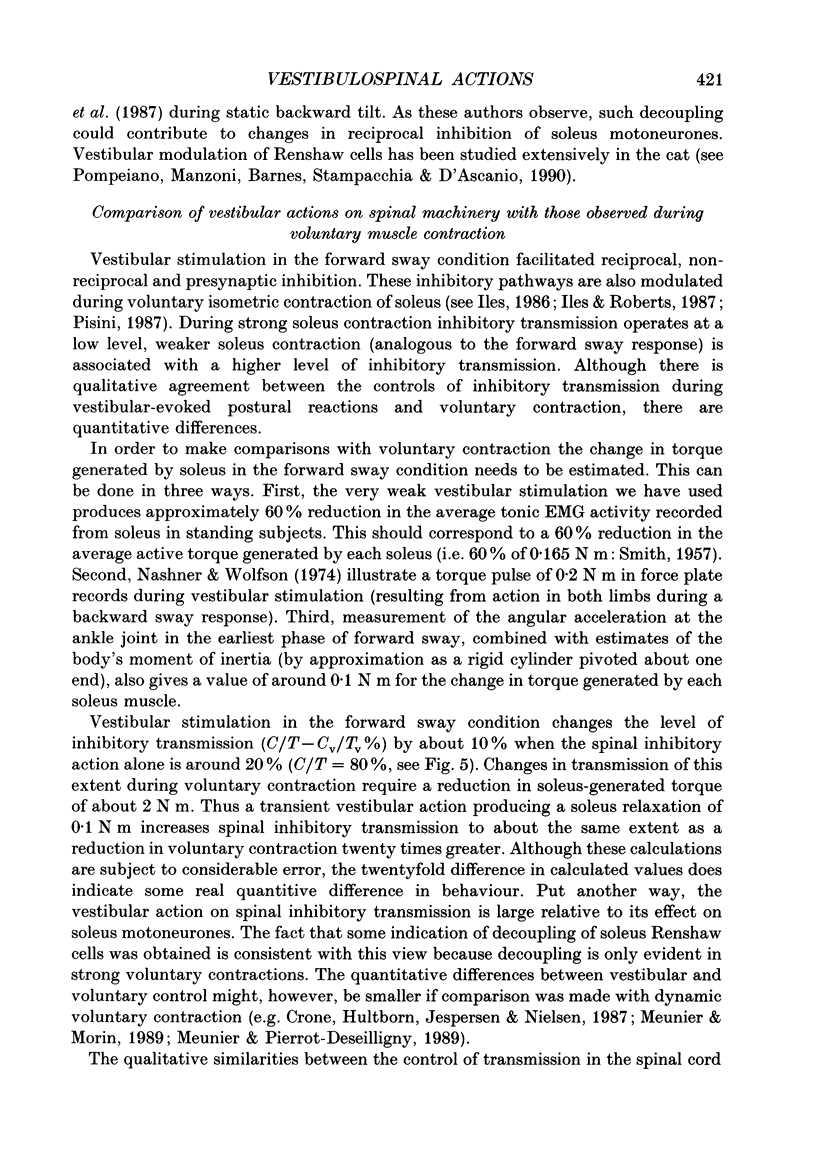
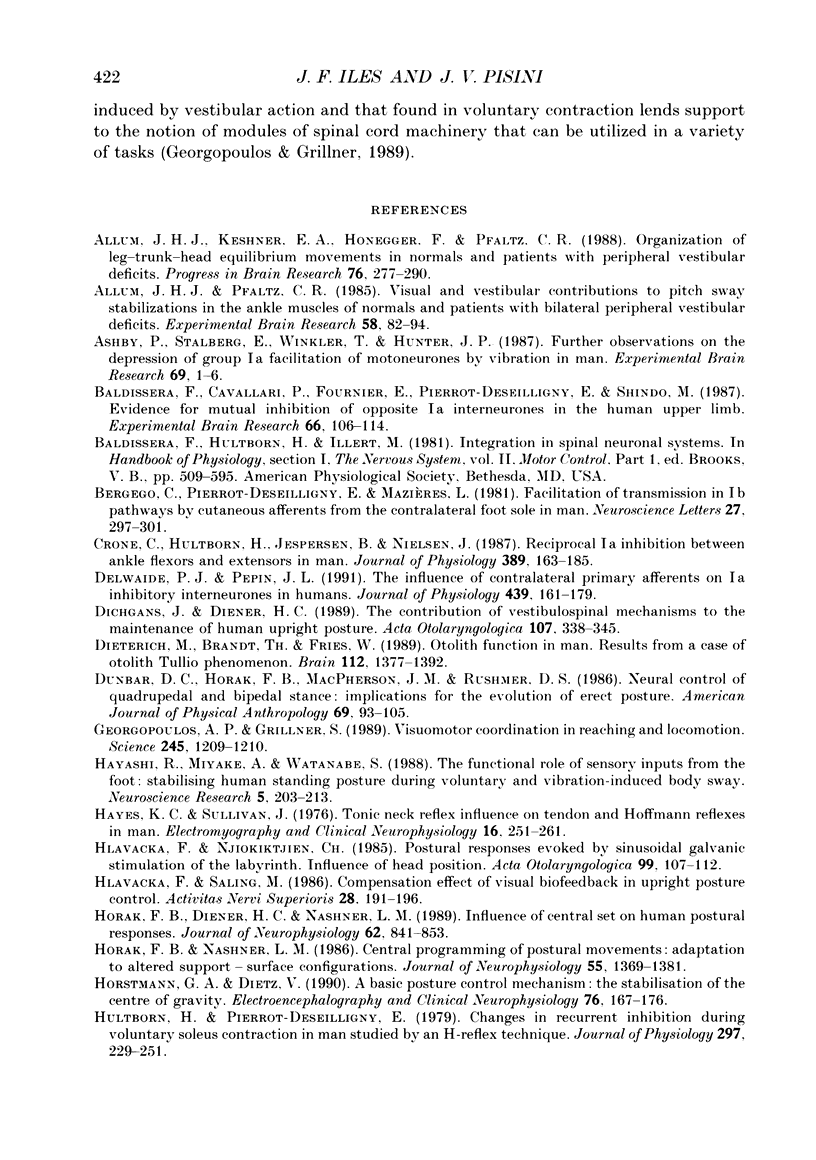
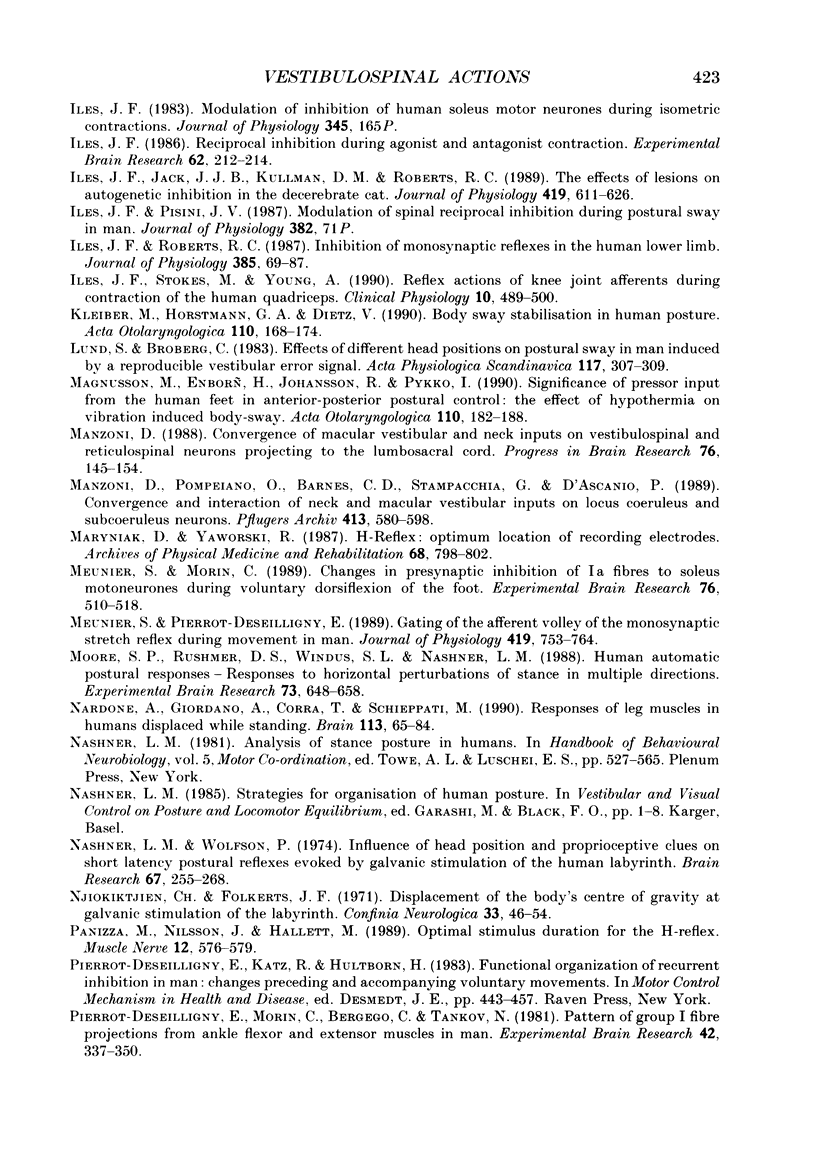
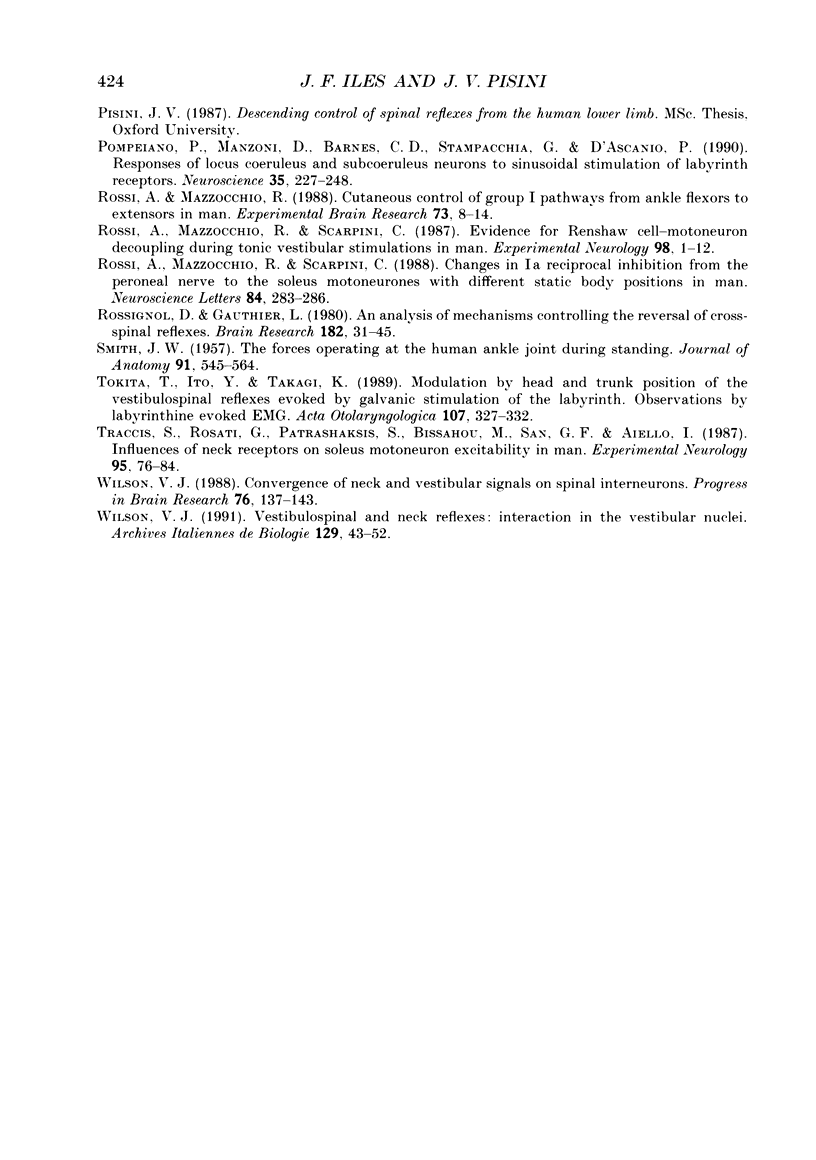
Selected References
These references are in PubMed. This may not be the complete list of references from this article.
- Allum J. H., Keshner E. A., Honegger F., Pfaltz C. R. Organization of leg-trunk-head equilibrium movements in normals and patients with peripheral vestibular deficits. Prog Brain Res. 1988;76:277–290. doi: 10.1016/s0079-6123(08)64514-8. [DOI] [PubMed] [Google Scholar]
- Allum J. H., Pfaltz C. R. Visual and vestibular contributions to pitch sway stabilization in the ankle muscles of normals and patients with bilateral peripheral vestibular deficits. Exp Brain Res. 1985;58(1):82–94. doi: 10.1007/BF00238956. [DOI] [PubMed] [Google Scholar]
- Ashby P., Stålberg E., Winkler T., Hunter J. P. Further observations on the depression of group Ia facilitation of motoneurons by vibration in man. Exp Brain Res. 1987;69(1):1–6. doi: 10.1007/BF00247023. [DOI] [PubMed] [Google Scholar]
- Baldissera F., Cavallari P., Fournier E., Pierrot-Deseilligny E., Shindo M. Evidence for mutual inhibition of opposite Ia interneurones in the human upper limb. Exp Brain Res. 1987;66(1):106–114. doi: 10.1007/BF00236207. [DOI] [PubMed] [Google Scholar]
- Bergego C., Pierrot-Deseilligny E., Mazieres L. Facilitation of transmission in Ib pathways by cutaneous afferents from the contralateral foot sole in man. Neurosci Lett. 1981 Dec 23;27(3):297–301. doi: 10.1016/0304-3940(81)90446-8. [DOI] [PubMed] [Google Scholar]
- Crone C., Hultborn H., Jespersen B., Nielsen J. Reciprocal Ia inhibition between ankle flexors and extensors in man. J Physiol. 1987 Aug;389:163–185. doi: 10.1113/jphysiol.1987.sp016652. [DOI] [PMC free article] [PubMed] [Google Scholar]
- Delwaide P. J., Pepin J. L. The influence of contralateral primary afferents on Ia inhibitory interneurones in humans. J Physiol. 1991 Aug;439:161–179. doi: 10.1113/jphysiol.1991.sp018662. [DOI] [PMC free article] [PubMed] [Google Scholar]
- Dichgans J., Diener H. C. The contribution of vestibulo-spinal mechanisms to the maintenance of human upright posture. Acta Otolaryngol. 1989 May-Jun;107(5-6):338–345. doi: 10.3109/00016488909127518. [DOI] [PubMed] [Google Scholar]
- Dieterich M., Brandt T., Fries W. Otolith function in man. Results from a case of otolith Tullio phenomenon. Brain. 1989 Oct;112(Pt 5):1377–1392. doi: 10.1093/brain/112.5.1377. [DOI] [PubMed] [Google Scholar]
- Dunbar D. C., Horak F. B., Macpherson J. M., Rushmer D. S. Neural control of quadrupedal and bipedal stance: implications for the evolution of erect posture. Am J Phys Anthropol. 1986 Jan;69(1):93–105. doi: 10.1002/ajpa.1330690111. [DOI] [PubMed] [Google Scholar]
- Georgopoulos A. P., Grillner S. Visuomotor coordination in reaching and locomotion. Science. 1989 Sep 15;245(4923):1209–1210. doi: 10.1126/science.2675307. [DOI] [PubMed] [Google Scholar]
- Hayashi R., Miyake A., Watanabe S. The functional role of sensory inputs from the foot: stabilizing human standing posture during voluntary and vibration-induced body sway. Neurosci Res. 1988 Feb;5(3):203–213. doi: 10.1016/0168-0102(88)90049-1. [DOI] [PubMed] [Google Scholar]
- Hayes K. C., Sullivan J. Tonic neck reflex influence on tendon and Hoffmann reflexes in man. Electromyogr Clin Neurophysiol. 1976 Apr-Jul;16(2-3):251–261. [PubMed] [Google Scholar]
- Hlavacka F., Njiokiktjien C. Postural responses evoked by sinusoidal galvanic stimulation of the labyrinth. Influence of head position. Acta Otolaryngol. 1985 Jan-Feb;99(1-2):107–112. doi: 10.3109/00016488509119152. [DOI] [PubMed] [Google Scholar]
- Hlavacka F., Saling M. Compensation effect of visual biofeedback in upright posture control. Act Nerv Super (Praha) 1986 Sep;28(3):191–196. [PubMed] [Google Scholar]
- Horak F. B., Diener H. C., Nashner L. M. Influence of central set on human postural responses. J Neurophysiol. 1989 Oct;62(4):841–853. doi: 10.1152/jn.1989.62.4.841. [DOI] [PubMed] [Google Scholar]
- Horak F. B., Nashner L. M. Central programming of postural movements: adaptation to altered support-surface configurations. J Neurophysiol. 1986 Jun;55(6):1369–1381. doi: 10.1152/jn.1986.55.6.1369. [DOI] [PubMed] [Google Scholar]
- Horstmann G. A., Dietz V. A basic posture control mechanism: the stabilization of the centre of gravity. Electroencephalogr Clin Neurophysiol. 1990 Aug;76(2):165–176. doi: 10.1016/0013-4694(90)90214-5. [DOI] [PubMed] [Google Scholar]
- Hultborn H., Pierrot-Deseilligny E. Changes in recurrent inhibition during voluntary soleus contractions in man studied by an H-reflex technique. J Physiol. 1979 Dec;297(0):229–251. doi: 10.1113/jphysiol.1979.sp013037. [DOI] [PMC free article] [PubMed] [Google Scholar]
- Iles J. F., Jack J. J., Kullmann D. M., Roberts R. C. The effects of lesions on autogenetic inhibition in the decerebrate cat. J Physiol. 1989 Dec;419:611–625. doi: 10.1113/jphysiol.1989.sp017889. [DOI] [PMC free article] [PubMed] [Google Scholar]
- Iles J. F. Reciprocal inhibition during agonist and antagonist contraction. Exp Brain Res. 1986;62(1):212–214. doi: 10.1007/BF00237419. [DOI] [PubMed] [Google Scholar]
- Iles J. F., Roberts R. C. Inhibition of monosynaptic reflexes in the human lower limb. J Physiol. 1987 Apr;385:69–87. doi: 10.1113/jphysiol.1987.sp016484. [DOI] [PMC free article] [PubMed] [Google Scholar]
- Iles J. F., Stokes M., Young A. Reflex actions of knee joint afferents during contraction of the human quadriceps. Clin Physiol. 1990 Sep;10(5):489–500. doi: 10.1111/j.1475-097x.1990.tb00828.x. [DOI] [PubMed] [Google Scholar]
- Kleiber M., Horstmann G. A., Dietz V. Body sway stabilization in human posture. Acta Otolaryngol. 1990 Sep-Oct;110(3-4):168–174. doi: 10.3109/00016489009122533. [DOI] [PubMed] [Google Scholar]
- Lund S., Broberg C. Effects of different head positions on postural sway in man induced by a reproducible vestibular error signal. Acta Physiol Scand. 1983 Feb;117(2):307–309. doi: 10.1111/j.1748-1716.1983.tb07212.x. [DOI] [PubMed] [Google Scholar]
- Magnusson M., Enbom H., Johansson R., Pyykkö I. Significance of pressor input from the human feet in anterior-posterior postural control. The effect of hypothermia on vibration-induced body-sway. Acta Otolaryngol. 1990 Sep-Oct;110(3-4):182–188. doi: 10.3109/00016489009122535. [DOI] [PubMed] [Google Scholar]
- Manzoni D. Convergence of macular vestibular and neck inputs on vestibulospinal and reticulospinal neurons projecting to the lumbosacral cord. Prog Brain Res. 1988;76:145–154. doi: 10.1016/s0079-6123(08)64500-8. [DOI] [PubMed] [Google Scholar]
- Manzoni D., Pompeiano O., Barnes C. D., Stampacchia G., d'Ascanio P. Convergence and interaction of neck and macular vestibular inputs on locus coeruleus and subcoeruleus neurons. Pflugers Arch. 1989 Apr;413(6):580–598. doi: 10.1007/BF00581807. [DOI] [PubMed] [Google Scholar]
- Maryniak O., Yaworski R. H-reflex: optimum location of recording electrodes. Arch Phys Med Rehabil. 1987 Nov;68(11):798–802. [PubMed] [Google Scholar]
- Meunier S., Morin C. Changes in presynaptic inhibition of Ia fibres to soleus motoneurones during voluntary dorsiflexion of the foot. Exp Brain Res. 1989;76(3):510–518. doi: 10.1007/BF00248907. [DOI] [PubMed] [Google Scholar]
- Meunier S., Pierrot-Deseilligny E. Gating of the afferent volley of the monosynaptic stretch reflex during movement in man. J Physiol. 1989 Dec;419:753–763. doi: 10.1113/jphysiol.1989.sp017896. [DOI] [PMC free article] [PubMed] [Google Scholar]
- Moore S. P., Rushmer D. S., Windus S. L., Nashner L. M. Human automatic postural responses: responses to horizontal perturbations of stance in multiple directions. Exp Brain Res. 1988;73(3):648–658. doi: 10.1007/BF00406624. [DOI] [PubMed] [Google Scholar]
- Nardone A., Giordano A., Corrà T., Schieppati M. Responses of leg muscles in humans displaced while standing. Effects of types of perturbation and of postural set. Brain. 1990 Feb;113(Pt 1):65–84. doi: 10.1093/brain/113.1.65. [DOI] [PubMed] [Google Scholar]
- Nashner L. M., Wolfson P. Influence of head position and proprioceptive cues on short latency postural reflexes evoked by galvanic stimulation of the human labyrinth. Brain Res. 1974 Feb 22;67(2):255–268. doi: 10.1016/0006-8993(74)90276-5. [DOI] [PubMed] [Google Scholar]
- Njiokiktjien C., Folkerts J. F. Displacement of the body's centre of gravity at galvanic stimulation of the labyrinth. Confin Neurol. 1971;33(1):46–54. doi: 10.1159/000103102. [DOI] [PubMed] [Google Scholar]
- Panizza M., Nilsson J., Hallett M. Optimal stimulus duration for the H reflex. Muscle Nerve. 1989 Jul;12(7):576–579. doi: 10.1002/mus.880120708. [DOI] [PubMed] [Google Scholar]
- Pierrot-Deseilligny E., Katz R., Hultborn H. Functional organization of recurrent inhibition in man: changes preceding and accompanying voluntary movements. Adv Neurol. 1983;39:443–457. [PubMed] [Google Scholar]
- Pierrot-Deseilligny E., Morin C., Bergego C., Tankov N. Pattern of group I fibre projections from ankle flexor and extensor muscles in man. Exp Brain Res. 1981;42(3-4):337–350. doi: 10.1007/BF00237499. [DOI] [PubMed] [Google Scholar]
- Pompeiano O., Manzoni D., Barnes C. D., Stampacchia G., d'Ascanio P. Responses of locus coeruleus and subcoeruleus neurons to sinusoidal stimulation of labyrinth receptors. Neuroscience. 1990;35(2):227–248. doi: 10.1016/0306-4522(90)90078-i. [DOI] [PubMed] [Google Scholar]
- Rossi A., Mazzocchio R. Cutaneous control of group I pathways from ankle flexors to extensors in man. Exp Brain Res. 1988;73(1):8–14. doi: 10.1007/BF00279655. [DOI] [PubMed] [Google Scholar]
- Rossi A., Mazzocchio R., Scarpini C. Changes in Ia reciprocal inhibition from the peroneal nerve to the soleus alpha-motoneurons with different static body positions in man. Neurosci Lett. 1988 Feb 3;84(3):283–286. doi: 10.1016/0304-3940(88)90521-6. [DOI] [PubMed] [Google Scholar]
- Rossi A., Mazzocchio R., Scarpini C. Evidence for Renshaw cell-motoneuron decoupling during tonic vestibular stimulation in man. Exp Neurol. 1987 Oct;98(1):1–12. doi: 10.1016/0014-4886(87)90066-5. [DOI] [PubMed] [Google Scholar]
- Rossignol S., Gauthier L. An analysis of mechanisms controlling the reversal of crossed spinal reflexes. Brain Res. 1980 Jan 20;182(1):31–45. doi: 10.1016/0006-8993(80)90828-8. [DOI] [PubMed] [Google Scholar]
- SMITH J. W. The forces operating at the human ankle joint during standing. J Anat. 1957 Oct;91(4):545–564. [PMC free article] [PubMed] [Google Scholar]
- Tokita T., Ito Y., Takagi K. Modulation by head and trunk positions of the vestibulo-spinal reflexes evoked by galvanic stimulation of the labyrinth. Observations by labyrinthine evoked EMG. Acta Otolaryngol. 1989 May-Jun;107(5-6):327–332. doi: 10.3109/00016488909127516. [DOI] [PubMed] [Google Scholar]
- Traccis S., Rosati G., Patraskakis S., Bissakou M., Sau G. F., Aiello I. Influences of neck receptors on soleus motoneuron excitability in man. Exp Neurol. 1987 Jan;95(1):76–84. doi: 10.1016/0014-4886(87)90008-2. [DOI] [PubMed] [Google Scholar]
- Wilson V. J. Convergence of neck and vestibular signals on spinal interneurons. Prog Brain Res. 1988;76:137–143. doi: 10.1016/s0079-6123(08)64499-4. [DOI] [PubMed] [Google Scholar]
- Wilson V. J. Vestibulospinal and neck reflexes: interaction in the vestibular nuclei. Arch Ital Biol. 1991 Jan;129(1):43–52. [PubMed] [Google Scholar]


